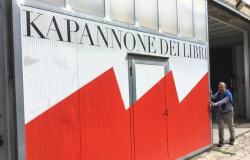The spotlight has been turned on the precious drawing by Andrea Mantegna depicting the «Deposition»the protagonist work of the new episode of the program «Ptm Andata/Ritorno», the format of Brescia Museums Foundation which transforms the departures of works from the civic collections – connected to loan requests – into arrivals of other works in the room, which dialogue with the permanent collection offering new perspectives of interpretation and reading.
The admirable drawing by the Paduan artist made in pen and brown ink on paper, dating back to around 1460-1465, has been featured since yesterday in Room One of the Pinacoteca Tosio Martinengo, occupying the space usually reserved for the painting «Saint George and the Dragon»which in the coming months will be exhibited in the XX International Art Exhibition «Il Coraggio» in Illegio, in the province of Udine.
For the “Deposition” it is actually a return, 15 years after Mantegna’s work was exhibited for a few days in the Pinacoteca, in January 2009 – returning to Brescia after being hosted at the Louvre – for the exhibition «CapoLavori in progress». Now, the most precious sheet of the civic collection of drawings, which represented the Brescian collections in the world and which is usually kept for conservation reasons in the drawers of the Cabinet of Drawings and Prints, will remain on view until November 3rdaccompanied by intense study and analysis carried out by conservators Roberta D’Adda and Nicola Turati.
The work
The work, which arrived in the city collections in 1863, with the legacy of Camillo Brozzoni, testifies once again «the inexhaustible richness of Brescia’s heritage», underlined the director of the Brescia Museums Foundation, Stefano Karadjov, in the presentation which was also attended by the city councilor delegate for Culture, Francesco Tomasini. «We are showing a masterpiece which, on the occasion of another exhibition in 1992 in London and New York, revealed, thanks to a restoration, the verse with the design of the candelabra for ecclesiastical use. On the recto, however, with the marvelous deposition in the tomb, one can only admire the beauty and essentiality of the sculptural body and the chiaroscuro renderings of the Paduan master”.
From left: Tomasini, Bazoli, D’Adda, Turati and Karadjov at the presentation of Mantegna’s drawing in the Pinacoteca
Lines and traits connect this masterpiece to the cultural influences that, at the end of the 15th century, they prepared the ground for the debut of the great Renaissance paintingwhich in a few months (and after the recent exhibition entitled a Lorenzo Lotto) a new important event will be dedicated in the city. This is the 13th Andata/Ritorno temporary project and it is also made possible – recalled the president of Brescia Musei Francesca Bazoli – by the enlightened patronage of Brescia collectors, to whom the Foundation extends the invitation to compete for the creation of the future technical museum , for archiving the numerous masterpieces supplied.
The “Deposition”, explained Turati, constitutes an extraordinary document and one of the most authentic for the development of the new Renaissance style by the Paduan master, characterized as it is by a continuity of themes and compositional variations compared to some other drawings kept in prestigious public and private collections.

Mantegna’s Deposition in the Art Gallery
«It allows you to trace the artist’s thoughts, in following lines and shapes and contains its “trademark”, i.e. the definition of volumes, rendered through chiaroscuro, through shadows that become thicker and sparser, more marked and softer depending on the variation of the light and in relation to formal needs. Mantegna, as evidenced by the numerous variations during the work, progressively investigates and defines the composition of the scene, with the Savior’s body foreshortened diagonally and taken from different angles”.
The presence of Mantegna’s sheet in the first room of the Pinacoteca establishes, observes the curator D’Adda, an ideal bond, albeit “in absentia” and in discontinuity in this case, with «Saint George and the Dragon». Both works bear witness to an example of the eclectic nature of the Brescian tradition and its ability to take on excellent references to summarize them in a new and original language.





